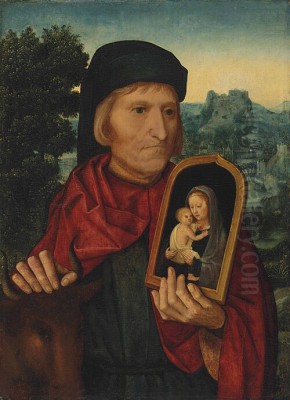
Ambrosius Benson stands as a fascinating figure in the Northern Renaissance, an artist whose Italian origins infused the vibrant artistic milieu of Bruges with a distinct sensibility. Active during the first half of the 16th century, Benson became one of the leading painters in Bruges following the death of Gerard David, developing a successful workshop and exporting numerous works, particularly to the lucrative Spanish market. Though often overshadowed by earlier Flemish masters like Jan van Eyck or Hans Memling, Benson's contributions were significant, characterized by rich colour, soft modelling, and a particular talent for devotional imagery and depictions of contemplative women.
From Lombardy to Flanders: An Artist's Journey
Pinpointing Ambrosius Benson's exact origins remains a challenge for art historians, though evidence strongly suggests he hailed from the Lombardy region of Italy. Born around 1495-1500, his birthplace might have been Milan or perhaps Ferrara. Some early documents refer to him with names suggesting an Italian background, possibly linked to Ferrara and the name 'San Marco'. Whatever his precise starting point, his artistic destiny lay northward, in the bustling commercial and artistic hub of Bruges.
By the early 16th century, Bruges, while perhaps slightly past its absolute zenith of the 15th century under artists like Memling, remained a crucial centre for art production and trade. It attracted artists and merchants from across Europe. It was into this environment that Benson arrived, likely seeking training and opportunity. The allure of the Flemish tradition, renowned for its meticulous detail and oil painting techniques pioneered by figures like Jan van Eyck and Rogier van der Weyden, drew many aspiring artists.
Benson's presence in Bruges is firmly documented by 1518, the year he acquired citizenship in the city. This was a necessary step for establishing himself professionally. Shortly thereafter, in 1519, he achieved the status of an independent master painter, formally enrolling in the Guild of Saint Luke and Saint Eligius – the guild encompassing painters, sculptors, and saddle-makers in Bruges. This membership granted him the right to establish his own workshop, take on apprentices, and sell his work independently.
Training with Gerard David and Early Career
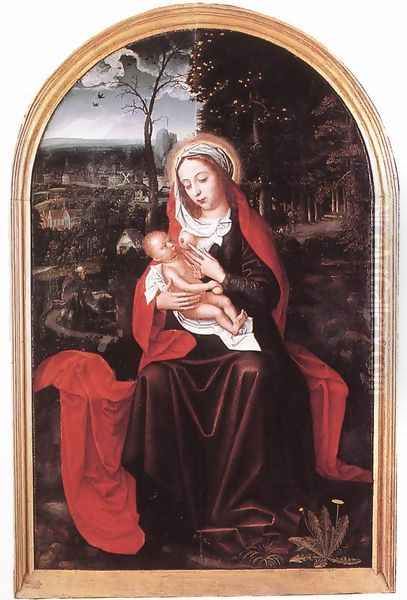
Before becoming an independent master, Benson spent time, albeit perhaps briefly, in the workshop of Gerard David. David was, at that time, the preeminent painter in Bruges, having inherited the mantle from Hans Memling. David's style, known for its calm serenity, refined technique, and balanced compositions, undoubtedly left an impression on the young Italian artist. Benson would have learned the meticulous Flemish techniques of oil painting, underpainting, and glazing, as well as compositional strategies prevalent in the Bruges school.
However, the relationship between master and pupil was not entirely smooth. Records indicate a legal dispute arose between Benson and David. While the exact details are scarce, it seems Benson may have left David's workshop under contentious circumstances, perhaps related to materials, commissions, or artistic differences. This falling out, however, did not impede Benson's progress. He swiftly established his own independent practice.
His Italian background likely gave him a unique perspective within the Bruges art scene. While deeply absorbing the Flemish aesthetic, he retained elements potentially derived from Italian art, particularly in his handling of light and shadow and perhaps a certain softness in modelling figures, which contrasted slightly with the sometimes harder linearity of his northern contemporaries. This blend of influences would become a hallmark of his developing style.
The Benson Style: A Synthesis of North and South
Ambrosius Benson forged a distinctive artistic style that, while rooted in the Bruges tradition inherited from Gerard David, incorporated his own preferences and likely his Italian heritage. His works are often characterized by a warm, rich palette, employing vibrant reds, deep greens, and luminous golds, often set against darker backgrounds to enhance the figures' presence. He favoured strong colour contrasts, contributing to the visual appeal and emotional resonance of his paintings.
Compared to the often cool, crystalline light found in the works of earlier Flemish masters, Benson sometimes employed a softer modelling, hinting at the Italian technique of sfumato – the subtle blurring of contours to create a more atmospheric effect. While not as pronounced as in the works of Leonardo da Vinci or his Lombard contemporaries, this tendency towards softer transitions, particularly in faces and flesh tones, lent his figures a gentle, approachable quality.
His compositions are typically well-balanced, often focusing on half-length or three-quarter-length figures presented in intimate settings. He paid considerable attention to the rendering of textures – luxurious fabrics, gleaming jewels, reflective surfaces – upholding the Flemish tradition of meticulous detail. Yet, his figures often possess a certain idealized beauty and serene composure that feels distinct. He frequently depicted elegant, elongated hands, a characteristic feature found in many works attributed to him and his workshop.
Themes and Subjects: Devotion and Contemplation
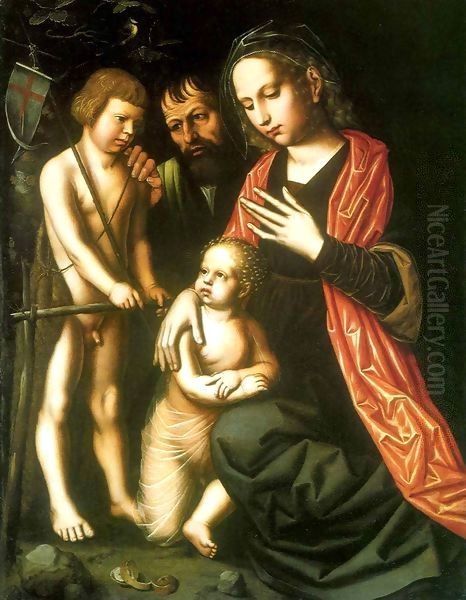
The vast majority of Ambrosius Benson's known oeuvre consists of religious subjects, catering to the strong demand for devotional art in the period, both for churches and private patrons. He produced numerous depictions of the Virgin and Child, often shown in tender, intimate moments. These works range from straightforward devotional images to more complex scenes like the Rest on the Flight into Egypt or variations on the Holy Family.
One of Benson's most recognizable and popular themes was the depiction of female saints or figures engrossed in reading. His paintings of the Magdalene Reading or the Persian Sibyl Reading became exceptionally sought after. These images portray elegantly dressed women, often in contemporary attire, absorbed in their books within richly appointed interiors. The quiet contemplation and intellectual focus of these figures resonated strongly with viewers, and Benson produced many variations on this theme. These works became so iconic that they were widely copied and served as models for other artists, even centuries later, particularly during the 19th-century revival of interest in early Netherlandish art.
Beyond these popular subjects, Benson also painted scenes from the lives of saints, such as his Altarpiece of Saint Anthony of Padua, and depictions of Christ, including Salvator Mundi (Savior of the World) images. While portraiture was not his primary focus, he did execute portraits, sometimes integrated into religious narratives or as independent commissions, often showcasing his skill in capturing likeness while adhering to contemporary ideals of status and piety. He also occasionally incorporated genre elements or detailed still-life passages within his religious compositions, adding layers of symbolism and visual interest.
Representative Works: Highlights of Benson's Oeuvre
Several key works exemplify Ambrosius Benson's style and thematic concerns. His depictions of the Holy Family are numerous, often showing Saint Joseph, the Virgin Mary, and the Christ Child in domestic or landscape settings. These works emphasize the humanity and tenderness of the sacred figures, making them relatable objects of devotion for contemporary viewers. The settings often include detailed landscapes or interiors, showcasing Benson's skill in rendering different textures and effects of light.
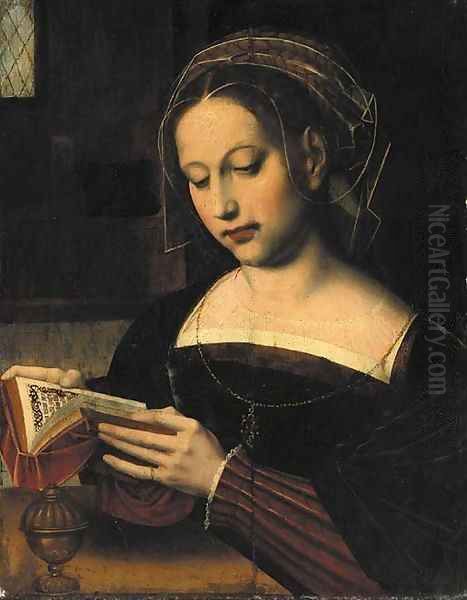
The Magdalene Reading exists in multiple versions attributed to Benson and his workshop, highlighting its popularity. Typically, Mary Magdalene is depicted as a sumptuously dressed noblewoman, her traditional attribute, the ointment jar, placed nearby. Her absorption in her book invites the viewer to contemplate piety and repentance. The rich fabrics of her dress and the detailed interior setting are characteristic of Benson's attention to material richness. Similar compositions feature other female saints or Sibyls, like the Persian Sibyl, often distinguished by specific attributes or inscriptions. These works are held in various collections, including the National Gallery, London.
The Altarpiece of Saint Anthony of Padua, originally created for a chapel in Bruges and now housed in the Musées Royaux des Beaux-Arts de Belgique in Brussels, demonstrates Benson's ability to handle larger-scale narrative compositions. The central panel depicts Saint Anthony, while the wings illustrate scenes from his life. The work showcases his characteristic use of colour and detailed rendering within a more complex, multi-panel format.
Another notable work is The Lamentation, found in the Museo del Prado, Madrid. This painting displays Benson's capacity for conveying pathos and emotion within a traditional religious scene. The composition, the expressive figures, and the rich colour scheme are typical of his mature style. The presence of numerous Benson works in Spanish collections like the Prado underscores his strong connection to that market.
The Workshop, Attribution, and the Spanish Connection
Like many successful masters of his time, Ambrosius Benson operated a productive workshop in Bruges. He would have employed assistants and apprentices to help meet the demand for his paintings. This workshop system often involved the master designing compositions, perhaps painting key passages like faces and hands, while assistants worked on backgrounds, drapery, or produced replicas of popular works. This practice complicates attribution, as distinguishing between the master's hand, collaborative pieces, and workshop copies can be challenging.
Further complicating matters is the fact that Benson rarely signed his paintings. While a few works bear monograms or inscriptions that have been linked to him, the vast majority are unattributed in this way. Art historians rely on stylistic analysis, comparison with documented works, and technical examination (like infrared reflectography revealing underdrawings) to group paintings under his name or attribute them to his circle. Consequently, the exact boundaries of his oeuvre remain a subject of scholarly discussion, with some works previously attributed to him now considered products of his workshop or followers.
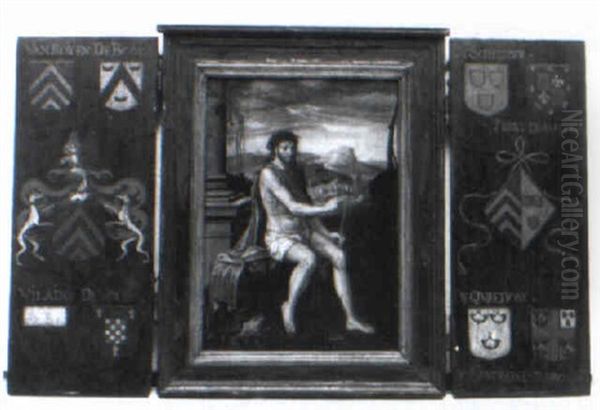
Despite these challenges, it is clear that Benson's workshop was highly successful, particularly in exporting works abroad. Spain emerged as a major market for his paintings. The strong commercial ties between Bruges and Spain, facilitated by resident Spanish merchants like Lucas de Castro (from whom Benson purchased property), created a direct channel for export. Benson's style, with its blend of Flemish detail and Italianate softness, combined with his focus on appealing devotional subjects, proved highly popular among Spanish patrons, both clerical and private. Numerous paintings by Benson and his workshop found their way into Spanish churches, monasteries, and private collections, where many remain today.
Contemporaries and Influence in Bruges
Within the Bruges art scene of the early to mid-16th century, Ambrosius Benson was a leading figure, but he worked alongside other notable artists. Adriaen Isenbrandt was another prominent painter active in Bruges during the same period, and his style sometimes bears similarities to Benson's, leading to past confusion in attributions. Both artists seem to have responded to the legacy of Gerard David, developing styles characterized by refinement and sweet expressions, though Isenbrandt's palette is often considered cooler than Benson's warm tones.
Other contemporaries in Bruges included Lancelot Blondeel, known more for his designs for tapestries and sculptural projects as well as paintings, often with elaborate architectural or decorative elements. Jan Provost, another painter who had connections to David's workshop, continued working in a style closer to the earlier Bruges tradition. Pieter Coecke van Aelst, though perhaps more associated with Antwerp later in his career, also spent time in Bruges and represents the growing influence of Italian Renaissance and Mannerist ideas. Benson's work fits within this context as a successful adaptation of the established Bruges style, subtly modernized with Italianate influences and a keen sense for market demands.
Benson's influence extended to his own family. His sons, Jan and Guillaume (Willem) Benson, also became painters. Guillaume, in particular, seems to have taken over his father's workshop after Ambrosius's death in 1550, likely completing unfinished commissions and continuing to produce works in a similar style. This continuation of the workshop further complicates the attribution of later Benson-style paintings.
Legacy and Later Appreciation
Ambrosius Benson's impact was most immediately felt through the widespread dissemination of his works, especially in Spain, where his paintings influenced local artists and contributed to the taste for Flemish art. His popular compositions, particularly the reading female saints, became standard types that were replicated and adapted for decades. His success demonstrates the continued vitality of Bruges as an art production center in the 16th century, even as Antwerp was rising in prominence.

While Benson may not have been a radical innovator on the scale of some of his Italian contemporaries or earlier Flemish pioneers, he was a highly skilled and successful painter who adeptly synthesized different artistic currents. He created a recognizable and appealing style that met the devotional and aesthetic needs of his patrons. His work represents a significant chapter in the story of the Northern Renaissance, particularly highlighting the cross-cultural exchanges between Italy and Flanders.
Interest in Benson waned in the centuries following his death, but his work saw a resurgence of appreciation in the 19th century, coinciding with a broader scholarly and popular rediscovery of early Netherlandish painting. His depictions of reading women, in particular, captured the imagination of collectors and artists during this period, leading to renewed study and, sometimes, misattributions as collectors sought works by the "master of the reading Magdalenes." Today, Ambrosius Benson is recognized as a key figure in 16th-century Bruges painting, an artist whose Italian roots enriched the Flemish tradition and whose workshop catered successfully to an international clientele. His works continue to be admired in museums worldwide for their rich colour, refined execution, and gentle, contemplative beauty.